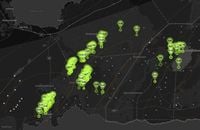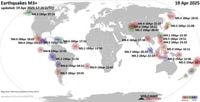A worldwide earthquake report for Saturday, April 19, 2025, reveals a significant level of seismic activity across various regions, with a total of 9 earthquakes recorded at a magnitude of 5 or higher. This report, updated hourly, highlights the ongoing geological activity that continues to shape our planet.
In the last 24 hours, there were 48 earthquakes with a magnitude of 4 or greater, and 148 earthquakes with a magnitude of 3. Additionally, a staggering 356 earthquakes were recorded at a magnitude of 2 or higher. Notably, no earthquakes of magnitude 6 or greater were reported during this period.
The estimated total seismic energy released during these events was approximately 1.1 x 1014 Joules, equivalent to 31.3 Gigawatt-hours or about 26,947 tons of TNT, which is comparable to the energy released by 1.7 atomic bombs. This immense energy release underscores the dynamic nature of Earth’s crust and the forces at play beneath the surface.
The strongest earthquake recorded was a magnitude 5.7 event that struck Badakhshan, Afghanistan, on Sunday, April 20, 2025, at 00:11 (GMT +8). This earthquake was closely followed by a magnitude 5.2 earthquake that occurred 23 km southwest of Tingo Maria, Huanuco, Peru, on Saturday, April 19, 2025, at 06:56 (Lima time).
Another significant event was a magnitude 5.1 earthquake that took place in the Central Mid-Atlantic Ridge on Saturday, April 19, 2025, at 11:50 (GMT -2). Additionally, a magnitude 4.9 earthquake was reported in the Southern Mid-Atlantic Ridge on Friday, April 18, 2025, at 18:15 (GMT -7).
Among the earthquakes that were felt by residents, the strongest was the magnitude 5.7 in Badakhshan, which received 116 reports of tremors. This was followed by a magnitude 4.3 earthquake in the Kenai Peninsula Borough, Alaska, which was reported 84 km west of Anchorage on Friday, April 18, 2025, at 23:18 (Anchorage time) and garnered 51 reports.
In the Caribbean, a magnitude 4.6 earthquake was recorded 27 km west of Barbuda, Antigua and Barbuda, on Friday, April 18, 2025, at 13:31 (Antigua time), with 39 reports of shaking felt by residents. Another notable event was a magnitude 5.9 earthquake in the Celebes Sea, located 96 km southwest of Surallah, Philippines, which was reported on Sunday, April 20, 2025, at 00:11 (GMT +8) and received 33 reports.
As seismic activity continues to be monitored, experts are particularly focused on the Reykjanes Peninsula in Iceland, where numerous weak earthquakes have been reported. This area has seen a significant increase in seismic activity, with almost 200 micro-earthquakes occurring at a depth of 4-5 kilometers over the last 48 hours. These tremors are concentrated in four sections: near Grindavik, north of Stora-Skogfell, and west of Keilir.
The Icelandic Meteorological Office has noted that the seismic activity along the dike near Sundhnúkur remains high. The recent uptick in activity at Fagradalsfjall is also noteworthy, as it suggests potential magma movement beneath the surface. Although no new intrusion has been reported, the increased seismicity raises concerns about the possibility of future eruptions.
In the Krysuvik system, a swarm of earthquakes has been observed, further indicating the dynamic geological processes at play. Experts speculate that fluid movements along the dikes and the ongoing tectonic activity may be contributing to the heightened seismic activity. There is a possibility that magma accumulation in deeper reservoirs could lead to increased pressures, resulting in more significant earthquakes and a potential rise in eruption risk.
As the situation develops, scientists are urging residents in seismically active regions to remain vigilant and prepared for possible aftershocks or volcanic activity. The interplay of tectonic plates and magma movements continues to be a subject of intense study, with researchers closely monitoring these developments.
In summary, the earthquake report for April 19, 2025, highlights a day marked by notable seismic events worldwide. With numerous earthquakes recorded, particularly in regions like Afghanistan, Peru, and the Mid-Atlantic Ridge, the data underscores the ongoing geological activity that shapes our planet. In Iceland, the Reykjanes Peninsula continues to be a focal point for monitoring due to its increased seismic activity, raising questions about future volcanic eruptions.
As we continue to learn more about these natural phenomena, it is essential to stay informed and prepared, as the Earth’s dynamic processes remind us of the power and unpredictability of nature.


